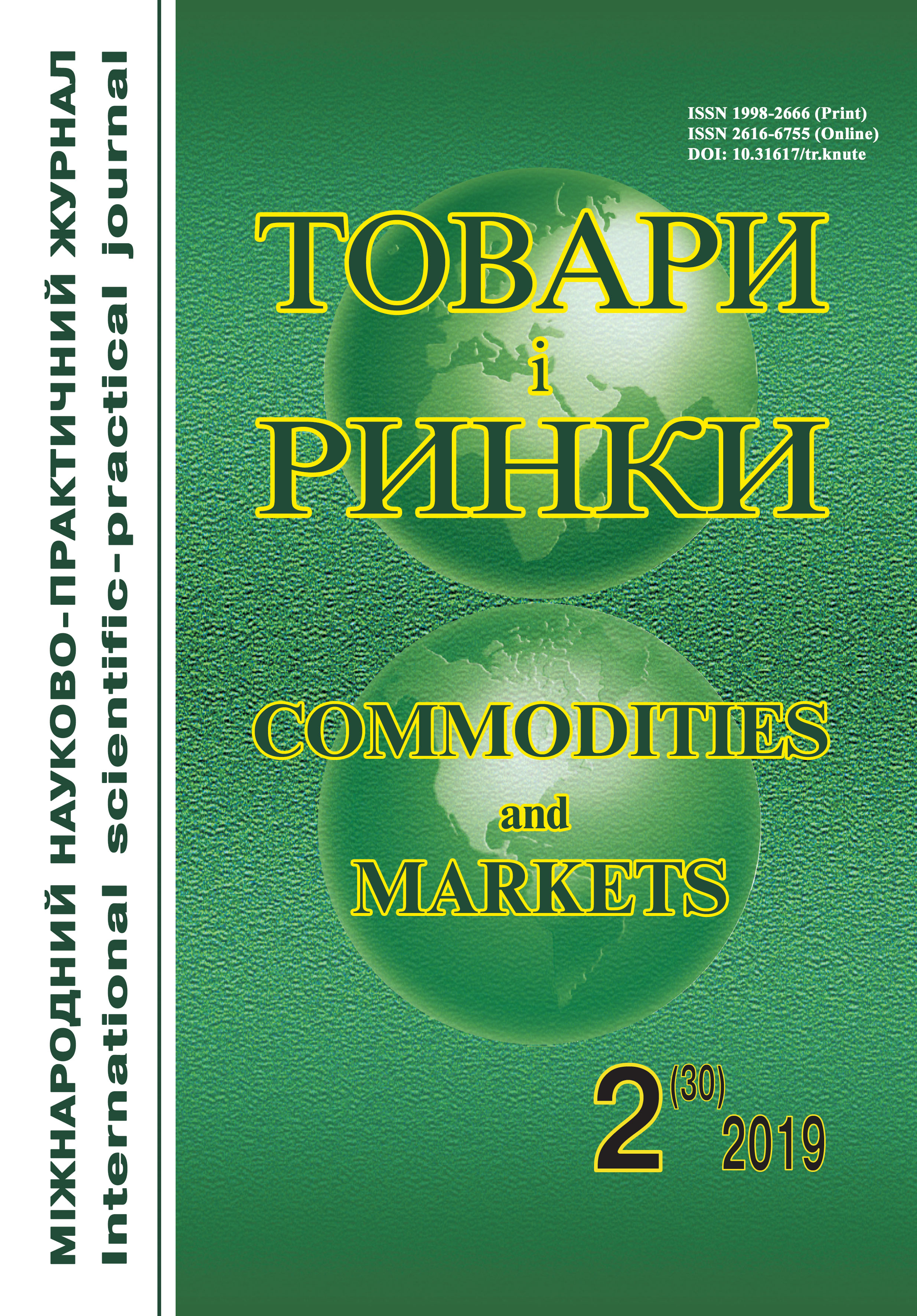Determination of ground coffee dispersion by microscopic method
DOI:
https://doi.org/10.31617/tr.knute.2019(30)03Keywords:
optical microscope, digital USB-microscope, automation of histological analysis, dispersion analysis, ground coffeeAbstract
Background. Determination of the sizes and forms of particles – elements of the dispersed phase, has a priority, since these parameters determine many of the physical and technological properties of the bulk product. The most common method of dispersion analysis of the investigated system is to determine the size, number and shape of particles by ready-made photos of the microstructure.
The aim of this article is to test equipment and software for disperse analysis of bulk materials on the example of ground coffee using optical digital microscopes.
Materials and methods. The study used digital microscopes 500xSDM, CL PC camera 4.5, BW-400X, which are included in the price range 2500–5000 UAH. All devices are not equipped with an eyepiece or their own display, have LED direct illumination and resolution matrix from 3 to 8 Mp.
The TM Lavazza coffee was investigated, from which four different samples were selected from different parts of the consumer packaging. Five photos of the microstructure have been made. The dispersion analysis of the coffee samples was made using software provided by microscopic manufacturers. The sizes of the particles of the coffee ground by the photos of the microstructure were determined. The photos were made by the method of "dark field" and "light field".
Results. The matrixes used in the microscopy study let you to make photos with sizes from 640´ 480 to 3264´ 2448 pixels and a resolution of 0.3 to 8 megapixels. Since the resolution of the matrix in the combination with the multiplicity of the lens determines the degree of magnification of the digital microscope, small particles of ground coffee have been photographed at the highest resolution.
The research results had been exported to MS Excel by software to automate the calculation of the average linear particle size of the disperse system. The analysis results of each microstructure photo were stored in a separate file. When the scale of the analyzed photo was reset, a new calibration was performed or one of the saved templates was used.
Overall, the results of the study indicate that the distribution of ground coffee particles is reproduced with a deviation of 1.5 % for all investigated devices using standard software and is best described by a polynomial third-order equation.
Conclusion. It was determined that the disperse composition of the sample of ground coffee with a particle size of 20–250 μm, determined using 500xSDM, CL PC camera 4.5, BW-400X microscopes in the software environment Cooling Tech 4.5, Micro-Measure Tool, Image Tool differed within 1.5 %, indicating the reliability of the results.
An algorithm for processing the results of the dispersion analysis of bulk products has been developed, which makes it possible to obtain reliable results of the study.
References
Burdo, O., Bandura, V., Zykov, A., & Zozulyak, I. (2017). Using of the wave technologies in intensification processes of heat and mass transf. EUREKA: Physics and Engineerin, 18-24. DOI: https://doi.org/10.21303/2461-4262.2017.00399 [in English].
Coalescers, Pall. (2012). Phase Separation Technology. NY: Pall Corporation [in English].
Saalfeld, S., Fetter, R., Cardona, A., & Tomancak, P. (2012). Elastic Volume Reconstruction from Series of Ultra-thin Microscopy Sections. Nature Methods, 9 (7), 717-720. DOI: https://doi.org/10.1038/nmeth.2072 [in English].
Schindelin, J., Arganda-Carreras, I., Frise, E., Kaynig, V., Longair, M., Pietzsch, T. et al. (2012). Fiji: an open-source platform for biological-image analysis. Nature Methods, 9 (7), 676-682. DOI: https://doi.org/10.1038/nmeth.2019 [in English].
Schneider, C. A., Rasband, W. S., & Eliceiri, K. W. (2012). NIH Image to ImageJ: 25 years of image analysis. Nature Methods, 9 (7), 671-675. DOI: https://doi.org/10.1038/nmeth.2089 [in English].
Mycik, A. V. (2011). Ispol'zovanie programmy ImageJ dlja avtomaticheskoj morfometrii v gistologicheskih issledovanijah [Using ImageJ software for automatic morphometry in histological studies]. Omskij nauchnyj vestnik – Omsk Scientific Herald, 2 (100), 187-189 [in Russian].
Eliceiri, K. W., Berthold, M. R., Goldberg, I. G., Ibanez, L., Manjunath, B. S., Martone, M. E. et al. (2012). Biological Imaging Software Tools. Nature Methods, 9 (7), 697-710. DOI: https://doi.org/10.1038/nmeth.2084 [in English].
Gavrilova, N. N., Nazarov, V. V., & Jarovaja, O. V. (2012). Mikroskopicheskie metody opredelenija razmerov chastic dispersnyh materialov [Microscopic methods for determining the particle size of dispersed materials]. Мoskow: RHTU im. D. I. Mendeleeva [in Russian].
Sviders'kyj, V. A. (2012). Dyspersnist' ta struktura karbonatnyh napovnjuvachiv dlja vodno-dyspersijnyh farb [The dispersion and structure of carbonate fillers for water-dispersive paints]. Visnyk Cherkas'kogo derzhavnogo tehnologichnogo universytetu – Bulletin of Cherkasy State Technological University, 2, 102-108 [in Ukrainian].
Shapoval, S. L., Romanenko, R. P., & Forostjana, N. P. (2017). Diagnostyka fizychnyh vlastyvostej harchovyh produktiv [Diagnostics of physical properties of food products]. Kyi'v: Kyi'vs'kyj nacional'nyj torgovel'no-ekonomichnyj universytet [in Ukrainian].
Resurs proektu z vidkrytym kodom ImageJ. Retrieved from https://imagej.net/ImageJ2#Features_of_ImageJ2 [in English].
Fedorova, D., & Romanenko, R. (2016). Kinetyka procesu sushinnja ta jakist' rybnyh napivfabrykativ [Kinetics of drying process and quality of fish semi-finished products]. Mizhnarodnyj naukovo-praktychnyj zhurnal "Tovary i rynky" – International scientific and practical magazine "Commoditiesand Markets", 2 (22), 158-177 [in Ukrainian].
Gorban', I. I. (2003). Teorija jmovirnostej i matematychna statystyka dlja naukovyh pracivnykiv ta inzheneriv [Probability theory and mathematical statistics for researchers and engineers]. Kyi'v: Instytut problem matematychnyh mashyn i system NAN Ukrai'ny [in Ukrainian].
Rasulov R. A., Romanenko R. P. (2019). Vplyv konstruktyvnogo typu kavomolky na dyspersnist' melenoi' kavy. Turyzm XXI stolittja: global'ni vyklyky ta cyvilizacijni cinnosti [Influence of constructive type of coffee grinder on the dispersion of ground coffee. XXI century tourism: global challenges and civilizational values]: Proceedings of the International Scientific and Practical Conference. (pp. 162-165). Kyi'v: Kyi'vs'kyj nacional'nyj torgovel'no-ekonomichnyj universytet [in Ukrainian].



